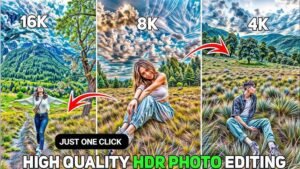In the digital age, where high-resolution visuals dominate the photography and media landscape, the demand for tools capable of handling large-scale, ultra-high-definition images has never been greater. One of the most remarkable advancements in this area is the 8K photo editor. This type of software allows users to edit photos at an 8K resolution—stunning visuals that provide extreme detail, clarity, and precision. As the photography industry and professional content creators continue to push boundaries, 8K editing is becoming essential for ensuring images are optimized for the latest screens and technologies.
In this article, we will dive into the world of 8K photo editors—what they are, how they work, their key features, and the pros and cons of using these powerful tools. Whether you’re a photographer, designer, or just a tech enthusiast interested in exploring 8K editing, this guide will provide valuable insights.
What is 8K Photo Editor?
An 8K photo editor refers to a specialized software or tool designed to handle images with a resolution of 7680 x 4320 pixels, commonly known as 8K. This resolution is four times that of 4K and sixteen times that of Full HD (1080p), offering a level of detail and sharpness that is unmatched in most traditional image editing software.

8K resolution is mostly used in professional settings, such as film, digital art, and photography, where every pixel counts. The 8K photo editor provides users with the ability to zoom in and manipulate images at a granular level, preserving the integrity and quality of the image even when subjected to significant edits.
Some of the most popular 8K photo editors include software like Adobe Photoshop, GIMP, Affinity Photo, and Capture One, all of which support 8K image editing. These tools are essential for professionals working in industries like advertising, media, and high-end photography.
How 8K Photo Editor Works
Working with 8K images requires a photo editor that is both powerful and efficient, as these images are typically very large in file size and require more processing power. The basic workflow in an 8K photo editor is similar to any other photo editing software but with enhanced capabilities to handle ultra-high-resolution files. Here’s how 8K photo editors work:
Step 1: Importing the 8K Image
The first step in any photo editing process is importing the image. When working with 8K images, the editor must be able to load the file without lagging. High-quality photo editors ensure the image is loaded into the software in its full resolution, retaining all the fine details.
Step 2: Editing Tools
Once the image is loaded, users can start editing. The core functions in an 8K photo editor typically include cropping, color correction, exposure adjustment, and more. However, because the image resolution is much higher, these tools are optimized for precision. For example, zooming into a specific part of the image in an 8K editor allows users to edit individual pixels without any loss of quality.
Step 3: Layer Manipulation
Most 8K photo editors offer support for layers, allowing users to add, delete, and manipulate layers in their images. This is crucial for complex photo compositions. When working at an 8K resolution, layer manipulation is enhanced for seamless blending, allowing for more detailed and intricate designs.
Step 4: Rendering and Exporting
After the edits are complete, the image must be rendered and exported. One of the challenges with 8K images is that exporting can take a longer time due to the file size and resolution. Top 8K photo editors optimize the exporting process, giving users a choice of file formats (such as JPG, PNG, or TIFF) without compromising on the image’s resolution or quality.
Features of 8K Photo Editor [Completely Detailing]
When choosing an 8K photo editor, it’s important to look at the features that set it apart from standard image editors. Here are the key features of a top-tier 8K photo editor:
1. High-Resolution Support
- Explanation: The primary feature of an 8K photo editor is its ability to support ultra-high-resolution images. These editors are capable of opening, editing, and exporting 8K photos without compressing or downgrading the resolution.
- Why It Matters: It ensures that every detail in the image is preserved, which is critical for professional photographers, videographers, and digital artists.
2. Advanced Layer Management
- Explanation: In high-end photo editing, working with layers allows for non-destructive edits. 8K photo editors offer advanced layer manipulation options, including the ability to group layers, adjust opacity, and apply blending modes.
- Why It Matters: Layers provide flexibility in editing, especially when dealing with complex compositions or creative projects.
3. Precise Pixel-Level Editing
- Explanation: These editors allow users to zoom in to a pixel level for precise editing, such as retouching blemishes, removing unwanted elements, or fine-tuning colors.
- Why It Matters: Precision is key when working with 8K images, as it ensures that even the smallest details are perfect.
4. Color Grading and Adjustment
- Explanation: Professional 8K photo editors offer in-depth color grading tools, allowing users to adjust hues, saturation, contrast, and white balance with high accuracy.
- Why It Matters: Proper color grading is essential in professional photography and media production, and working in 8K requires tools that maintain the integrity of the colors.
5. Efficient Rendering and Processing
- Explanation: Given the size of 8K images, rendering and processing can be time-consuming. The best 8K photo editors are optimized to handle large files efficiently, with minimal lag and fast processing times.
- Why It Matters: This feature is crucial for professionals who need to work on multiple high-resolution images without wasting time on slow processing.
6. Customizable Brushes and Tools
- Explanation: Editors like Adobe Photoshop and GIMP offer customizable brushes, allowing users to create specific textures and effects in their 8K images.
- Why It Matters: Custom brushes enable artists and editors to create unique designs that stand out in ultra-high-definition formats.
7. Non-Destructive Editing
- Explanation: Non-destructive editing ensures that changes made to the image do not permanently alter the original file. This is particularly useful when making adjustments to color, sharpness, or contrast.
- Why It Matters: This allows users to experiment with different effects without the risk of losing the original image data, which is important when working with high-resolution images.
8. Export to Multiple Formats
- Explanation: The ability to export 8K images in multiple formats (e.g., JPEG, PNG, TIFF) while maintaining the image’s resolution and quality is essential in a professional photo editor.
- Why It Matters: It allows users to work with a wide range of formats suitable for print, digital, or web use.
9. AI-Powered Tools
- Explanation: Some 8K photo editors integrate AI-based features, such as auto-enhancement, object recognition, and intelligent retouching.
- Why It Matters: AI-powered tools simplify the editing process by automating certain tasks, saving time while maintaining high-quality results.
Pros of 8K Photo Editor [Use Table]
| Pros | Description |
|---|---|
| Extremely High Detail | 8K resolution allows for editing at a granular level, perfect for professional use. |
| Precision Editing | Editors designed for 8K support pixel-level adjustments, ensuring detailed retouching. |
| Professional-Grade Tools | Advanced features like layer management, color grading, and customizable brushes are typically included. |
| Maintains Image Quality | Edits made in 8K photo editors preserve the original resolution and quality of the image. |
| Non-Destructive Workflow | Allows users to make edits without permanently altering the original image, enabling easy experimentation. |
| AI-Powered Features | Some editors include AI-based tools to streamline complex edits, like object removal or auto-enhancement. |
| Supports Multiple File Formats | Allows users to export images in high-resolution formats suitable for various applications (e.g., print, web, digital media). |
Cons of 8K Photo Editor [Use Table]
| Cons | Description |
|---|---|
| Requires High Processing Power | 8K images are large and require a powerful computer or device to handle the file size effectively. |
| Longer Rendering Times | Exporting or processing 8K images can take longer compared to lower-resolution images. |
| Learning Curve for Beginners | The advanced tools and features in 8K photo editors may be overwhelming for new users. |
| Higher Storage Requirements | 8K images take up more storage space, and continuous editing can quickly fill up storage devices. |
| Limited Compatibility with Devices | Not all devices or software platforms support 8K images or resolutions, limiting accessibility. |
| Cost of Software | Many professional-grade 8K photo editors are subscription-based or have high upfront costs. |
| Complex File Management | Managing and organizing large files can be difficult, especially for users working with multiple 8K projects. |
8K Photo Editor Alternatives [Use Table]
| Alternative | Description | Price |
|---|---|---|
| Adobe Photoshop | Industry-leading photo editor with full 8K support and advanced features. | Subscription |
| GIMP | Open-source photo editor with support for 8K image editing, offering a free alternative. | Free |
| Affinity Photo | High-quality photo editor with a one-time purchase model, providing robust 8K editing tools. | One-Time Payment |
| Capture One | Professional photo editing software with high-end 8K support, designed for photographers. | Subscription |
| Luminar AI | AI-powered photo editor that simplifies 8K editing with intelligent enhancement features. | One-Time Payment |
| Corel PaintShop Pro | User-friendly photo editor with support for 8K images and various creative tools. | One-Time Payment |
| DxO PhotoLab | A powerful image editor with excellent color correction and noise reduction for 8K photos. | One-Time Payment |
Conclusion and Verdict 8K Photo Editor
The rise of 8K photo editors has revolutionized the way professionals and enthusiasts handle high-resolution images. With unparalleled precision, advanced tools, and support for ultra-high-definition visuals, these editors cater to photographers, graphic designers, and media creators who demand the best in image quality. However, the use of such tools does come with some challenges, such as higher processing power requirements and the need for adequate storage space.
For professionals who rely on top-tier photo quality and detail, investing in an 8K photo editor is essential. Software like Adobe Photoshop, GIMP, and Affinity Photo provide excellent solutions, catering to different levels of expertise and budgets.
In conclusion, whether you’re working on digital artwork, photography, or media production, an 8K photo editor is a valuable asset. These tools deliver the precision and quality needed to meet the growing demands of ultra-high-resolution content creation.
FAQs 8K Photo Editor
1. Do I need a high-end computer to run 8K photo editors?
Yes, due to the large file sizes and high resolution, 8K photo editors typically require a powerful processor, plenty of RAM, and a high-quality display for the best performance.
2. Is 8K resolution necessary for casual photographers?
No, for most casual users, 4K or even Full HD is sufficient. 8K is mainly for professionals who need the highest level of detail in their images.
3. Can I edit 8K images on a 4K monitor?
Yes, most 8K photo editors allow you to work with 8K images on lower-resolution monitors, though you won’t see the full resolution until the image is viewed on an 8K display.
4. Are there any free 8K photo editors?
Yes, tools like GIMP offer free editing options for 8K images, though they may lack some advanced features of paid software.
5. What file formats are best for saving 8K images?
For maximum quality, saving in formats like TIFF or PNG is recommended, as these formats preserve the image resolution and details.




